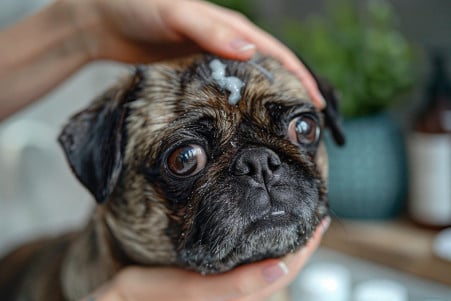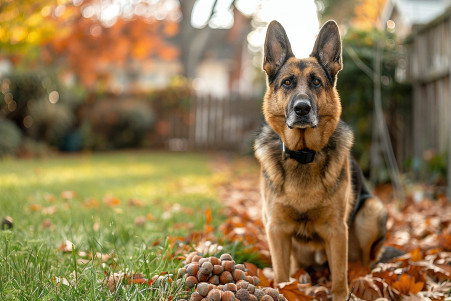Can Dogs Get Poison Oak? Protecting Pets From Itchy Rashes
6 May 2024 • Updated 6 May 2024

Dogs can develop skin rashes from poison oak, just like humans, but there are steps pet owners can take to prevent exposure and treat any reactions. If your furry friend has been scratching and licking more than usual after a walk in the woods, they may have come into contact with poison oak. Dogs are susceptible to the same rash-causing oils that make this plant so irritating for people. While not life-threatening, an encounter with poison oak can be quite uncomfortable for your pup.
To help dog owners navigate this itchy situation, we'll examine scientific research from veterinary experts on the causes, symptoms, and treatments for poison oak exposure in canines. We'll also explore preventative measures and home remedies for providing relief. With the insights gained from this analysis, you'll be better equipped to protect your beloved pet and promote their overall comfort and well-being.
Can dogs get poison oak?
How to Identify and Treat Poison Oak in Dogs
Signs of poison oak exposure in dogs can include red, swollen skin rashes, excessive licking, and scratching, according to WagWalking. As the reaction progresses, the skin may develop blisters, oozing sores, and scabs, especially in areas with less fur, such as the belly and muzzle, according to a veterinary technician at DogTrekker.
If a dog eats poison oak, they may also have symptoms of gastrointestinal upset, such as vomiting, diarrhea, and abdominal pain, according to Daily Paws. It's important to get the dog to a vet right away if they have a severe reaction or if they have ingested the plant. Treatment for poison oak exposure may include the use of topical creams, antihistamines, or corticosteroids to reduce inflammation and itching, and antibiotics to treat any secondary infections, according to the WagWalking overview.
Although most cases are mild, dogs can have severe allergic reactions to poison oak, including anaphylactic shock, which is life-threatening, and skin reactions like oozing blisters and excessive scratching that require medical attention, according to Daily Paws. A fever or loss of appetite may also be signs of a severe reaction to ingesting poison oak. It's important to get your dog treated right away to manage their exposure to poison oak and to prevent further complications.
How to Avoid Poison Oak in Dogs
The best way to prevent poison oak in dogs is to avoid areas where the plant grows, especially in the spring and summer months, says the Ollie Blog. When walking dogs in the woods or other natural areas, the FDA recommends keeping dogs on a leash and sticking to marked trails to minimize contact with plants.
Another way to prevent poison oak in dogs is to regularly check yards, gardens, and other outdoor areas for poison oak and remove any plants that are found, according to Tec Labs. After outdoor activities, the FDA says that checking dogs for signs of poison oak and bathing them with a degreasing shampoo or dish soap can help remove any urushiol oil that they may have come into contact with.
Finally, wearing gloves and long sleeves when handling a dog that may have poison oak can help prevent the spread of the oil to humans, according to the Tec Labs article. These steps can help dog owners avoid the unpleasantness of poison oak in their pets.
Breed Predisposition and Risk Factors
Although all dogs can potentially have a reaction to poison oak, certain breeds and individual dogs may be more predisposed to having a more severe reaction, according to Heart + Paw. Dogs with short hair or thin coats, such as Greyhounds, Whippets, and some terrier breeds, have less natural protection from the urushiol oil and are therefore more likely to have a skin reaction, the article explains.
In addition, dogs that spend more time outside, especially in the woods or close to the ground, are at a greater risk of coming into contact with poison oak, as pointed out by Tec Labs. Dogs that are immunocompromised or have pre-existing skin conditions are also more likely to have a more severe reaction because their immune systems are weaker, according to the Merck Veterinary Manual.
Age, health status, and individual sensitivity are other factors that can influence the severity of a dog's reaction to poison oak, according to the American Kennel Club. Given these risk factors, dog owners should be especially careful to protect their pets and make sure to get them to the vet if they notice any potential symptoms.
Home Remedies and Over-the-Counter Treatments
If your dog has a mild case of poison oak, there are a few home remedies and over-the-counter treatments that can help soothe their symptoms, says BetterPet. For example, oatmeal baths and a paste made from baking soda and water can help soothe itchy, inflamed skin and make your dog feel more comfortable, according to the WagWalking article. In addition, the Ollie Blog recommends gently applying coconut oil or calamine lotion to the affected areas to create a protective barrier and help the skin heal.
Vets may also recommend over-the-counter antihistamines like Benadryl to help control itching and inflammation, but it’s important to follow the dosing instructions carefully, notes WagWalking. That said, if your dog’s symptoms don’t improve or they get worse, it’s important to get them to a vet for a proper diagnosis and treatment, says the Ollie Blog. While home remedies can help dogs feel better, severe reactions will require medical care.
When to Go to the Vet
While many cases of poison oak exposure in dogs can be treated at home, there are some instances in which it is important to seek immediate veterinary care. According to the ASPCA, if a dog has eaten any part of the poison oak plant, it is important to get them to a vet right away because eating the plant can cause more serious gastrointestinal problems.
If a dog is experiencing a severe skin reaction, including widespread blistering, extreme swelling, or signs of infection, it is important to get them to a vet to avoid further complications, as mentioned by Zoetis Petcare. If a dog is having trouble breathing, swallowing, or showing signs of anaphylactic shock, it is important to seek immediate emergency veterinary care, according to the information provided by DogtTrekker.
Vets can administer the appropriate medications, including corticosteroids, antihistamines, and antibiotics, to treat severe reactions and prevent complications. If dogs receive prompt medical care, they can make a full recovery from poison oak exposure with no lasting effects, according to the ASPCA.
Conclusion: Keeping Your Dog Safe
The only way to avoid having to clean your dog every day is to avoid the exposure in the first place by keeping her away from the plants, such as by keeping her on a leash or taking a different path that doesn't have poison oak, according to Tec Labs.
To clean the oil off of your dog, you can use Tecnu Original Outdoor Skin Cleanser. Saturate a cloth with Tecnu Original and wipe down her coat. Then, bathe her with pet shampoo and water. Be sure to rinse her thoroughly so that she doesn't lick the Tecnu off of her fur, the article notes.
Pets like dogs can also get the rash if they brush up against the plants, as the oil can stick to their fur, according to the FDA. To prevent dogs from being exposed, it's recommended to wash your pet with pet shampoo and water if it may have come into contact with poison ivy, oak, or sumac. Wear rubber gloves when doing this, the FDA suggests.
The most important things to know about avoiding exposure and protecting dogs are how to identify poison ivy, oak, and sumac so you can steer clear of them, regularly washing your gardening equipment and gloves, and washing your dog's fur as soon as possible if you suspect it may have come into contact with the plants, according to the FDA.
With the right care and precautions, dogs can enjoy the great outdoors without the fear of developing an itchy, uncomfortable rash.


